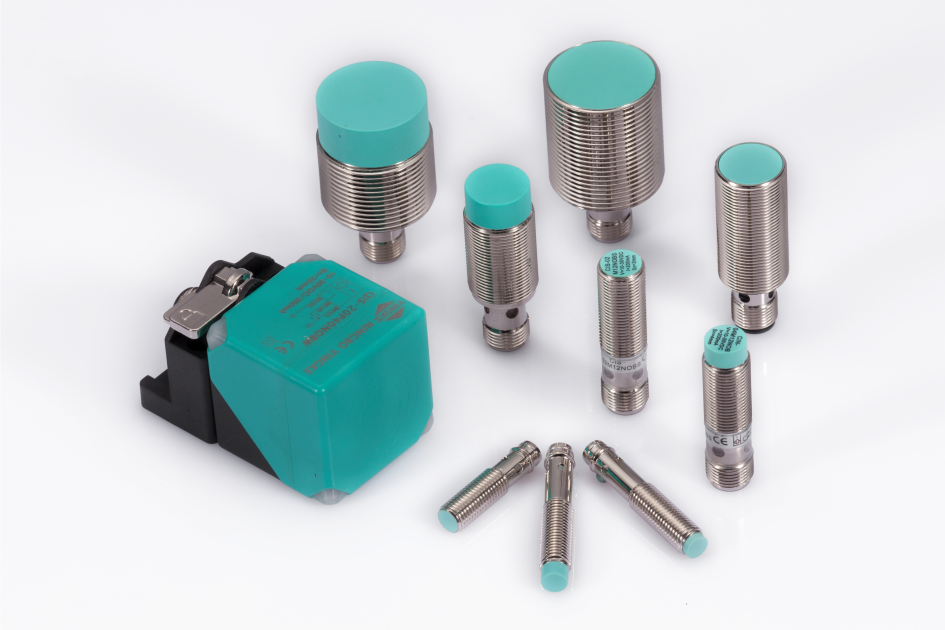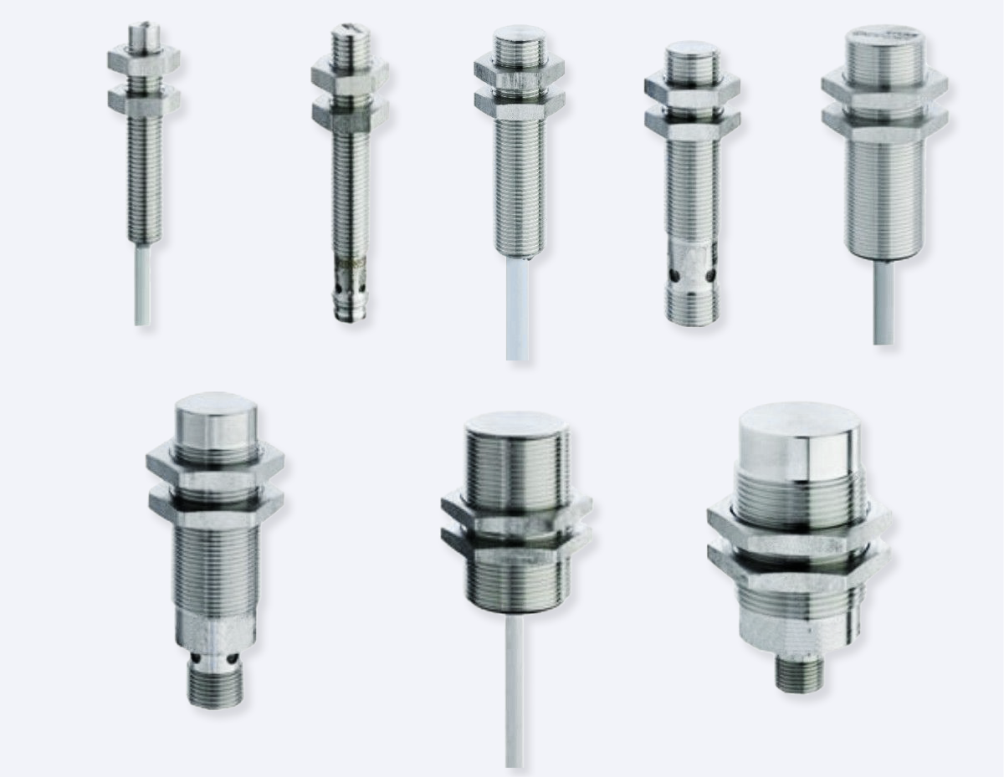A sensor is a detection device that can convert non electric changes in physical parameters such as temperature, humidity, light, etc. into another physical parameter, such as current, voltage, etc. Sensors are widely used in science and technology, from space exploration to deep-sea exploration, and are used everywhere.
Inductive sensor

Inductive sensors can detect metal objects and are mainly composed of three parts: 1 Oscillator 2 Trigger circuit 3 Output circuit.
After the power is turned on, the oscillator begins to oscillate and generate a specific current. The electromagnetic field generated by the oscillating coil is concentrated on the sensing surface of the sensor. When a target object made of conductive material approaches the sensing surface, eddy currents are generated inside the target object, consuming the energy of the oscillator and causing attenuation of the oscillating circuit. The amplitude of the oscillator decreases, and once it reaches a certain amplitude, the subsequent trigger circuit activates, generating a switch output. The characteristics of the inductive sensors produced by our company are:
- The variety is complete and can reach thousands.
- Excellent quality, designed and produced according to European standards.
- The sensing range is from 0.6-150mm.
- The protection function is complete, and in special circumstances, it will not cause damage to the sensor.
- The highest protection level can reach IP69K.
- Sensors can be customized according to the user's usage requirements and environment.
Automated Service Guide
Our sales staff and engineers will provide top-notch service and assist you in finding the best solution.
-
 Micro ultra short inductive sensorMicro ultra short inductive sensor
Micro ultra short inductive sensorMicro ultra short inductive sensorSmall inductive sensors are used in automation equipment.
- Simple structure: no active electrical contacts, long lifespan.
- High sensitivity: The output signal is strong, and the voltage sensitivity can reach hundreds of millivolts per millimeter.
- High resolution: capable of sensing small mechanical displacements and angle changes.
- Good repeatability and linearity: Within a certain displacement range, the linearity of the output characteristics is good and the output is stable.
-
 Standard inductive sensorStandard inductive sensor
Standard inductive sensorStandard inductive sensorInductive sensors are widely used in factory automation equipment, and standard inductive sensors are widely used in most situations.
-
 Distance enhanced inductive sensorDistance enhanced inductive sensor
Distance enhanced inductive sensorDistance enhanced inductive sensorIn the application process of inductive sensors, the induction distance of traditional standard inductive sensors cannot meet the requirements, so distance enhanced inductive sensors have been developed.
-
 High voltage resistant inductive sensorHigh voltage resistant inductive sensor
High voltage resistant inductive sensorHigh voltage resistant inductive sensorHigh voltage resistant inductive proximity switches are mainly used in hydraulic system equipment and hydraulic valves, and the sensing surface can withstand oil pressure of 500 bar. Used to sense whether the valve core is reset on hydraulic safety valves, and to sense the piston position on hydraulic cylinders.
-
 All metal inductive sensorAll metal inductive sensor
All metal inductive sensorAll metal inductive sensorBelonging to a special type of inductive sensor, some environments in factory automation equipment require inductive sensors with special shell materials, such as food industry, pharmaceutical equipment, marine engineering, industries with high anti-corrosion and hygiene, and can also be applied in harsh environments.
-
 Wide temperature range inductive sensorWide temperature range inductive sensor
Wide temperature range inductive sensorWide temperature range inductive sensorThis series of products is applied in places with harsh environmental temperatures, such as brewing and dairy equipment, rod and plate pressing equipment, and the steel industry.
-
 Analog output sensorAnalog output sensor
Analog output sensorAnalog output sensorThe purpose of analog output inductive sensors is to produce analog signals (0-10V or 0-20mA) within the sensing range of the sensor, which vary with the distance between the metal object and the sensing surface of the sensor. Mainly used in automation equipment that requires a standard analog signal. Such as grinding machines, steel industry, railway machinery, automotive industry, etc.
-
 Canal shaped circular inductive sensorCanal shaped circular inductive sensor
Canal shaped circular inductive sensorCanal shaped circular inductive sensor -
 Welding immune inductive sensorWelding immune inductive sensor
Welding immune inductive sensorWelding immune inductive sensorThis product is applied to the welding assembly line and automatic welding equipment of thousands of automobiles. In these welding magnetic field applications, the sensor surface must be coated with Teflon material to avoid sensor misoperation caused by welding slag sticking to the sensing surface. At the same time, it must also resist strong electromagnetic field interference.
-
 High protection level inductive sensorHigh protection level inductive sensor
High protection level inductive sensorHigh protection level inductive sensorThe high protection level inductive sensor adopts a full plastic shell and special sealing treatment is added at the back cover outlet, making the sensor resistant to high-pressure water impact. It is mainly used in the vehicle cleaning industry, railway vehicles, papermaking machinery, and garbage disposal machinery (the shell material is made of polytetrafluoroethylene).
-
 Corrosion resistant inductive sensorCorrosion resistant inductive sensor
Corrosion resistant inductive sensorCorrosion resistant inductive sensor -
 Type 1 inductive sensor with attenuation coefficientType 1 inductive sensor with attenuation coefficient
Type 1 inductive sensor with attenuation coefficientType 1 inductive sensor with attenuation coefficientThe Type 1 inductive sensor with attenuation coefficient adopts a special oscillation circuit, which solves the problem of different attenuation coefficients in traditional inductive sensors for different metal induction, without considering that the target object is a different metal.
-
 Suitable for mobile vehicle modelsSuitable for mobile vehicle models
Suitable for mobile vehicle modelsSuitable for mobile vehicle modelsThis product is mainly used in industries such as port machinery, construction machinery, railway vehicles, vehicle cleaning, brick and tile machinery, etc. Its characteristics are the ability to adapt to hot and cold climate environments, as well as resistance to vibration and impact, good sealing, oil resistance, resistance to coolant and cleaning agents, and the ability to withstand high-pressure water flushing.
-
 Intrinsically safe inductive sensorIntrinsically safe inductive sensorIntrinsically safe inductive sensors can be applied in hazardous areas, and under normal operating conditions, they do not generate arcs or sparks, nor do they produce high-temperature surfaces or hot spots that can ignite explosive mixtures around them, and generally do not have ignition effects or other malfunctions.Essentially Safe (NAMUR) sensors are widely used in environments with dust, flammable and explosive hazardous materials such as petrochemicals and coal mines.
Intrinsically safe inductive sensorIntrinsically safe inductive sensorIntrinsically safe inductive sensors can be applied in hazardous areas, and under normal operating conditions, they do not generate arcs or sparks, nor do they produce high-temperature surfaces or hot spots that can ignite explosive mixtures around them, and generally do not have ignition effects or other malfunctions.Essentially Safe (NAMUR) sensors are widely used in environments with dust, flammable and explosive hazardous materials such as petrochemicals and coal mines. -
 Speed monitoring type inductive sensorSpeed monitoring type inductive sensorThe speed monitoring type inductive sensor will activate the output switch when the attenuation state exceeds or falls below the reference frequency, and the reference frequency is adjusted through a built-in potentiometer. If the actual measured halo frequency Fact of the sensor is less than the reference frequency Fnom, the output will be turned off. If the actual measured halo frequency Fact of the sensor is close to the reference frequency Fnom output (switch on).This product is mainly used on devices that require speed monitoring.
Speed monitoring type inductive sensorSpeed monitoring type inductive sensorThe speed monitoring type inductive sensor will activate the output switch when the attenuation state exceeds or falls below the reference frequency, and the reference frequency is adjusted through a built-in potentiometer. If the actual measured halo frequency Fact of the sensor is less than the reference frequency Fnom, the output will be turned off. If the actual measured halo frequency Fact of the sensor is close to the reference frequency Fnom output (switch on).This product is mainly used on devices that require speed monitoring.

 Zhejiang Public Security Reserve 33020502000578
Zhejiang Public Security Reserve 33020502000578